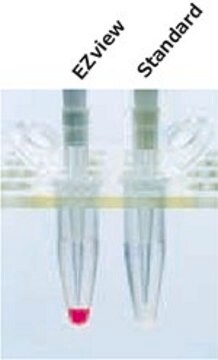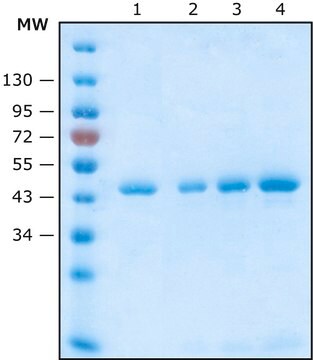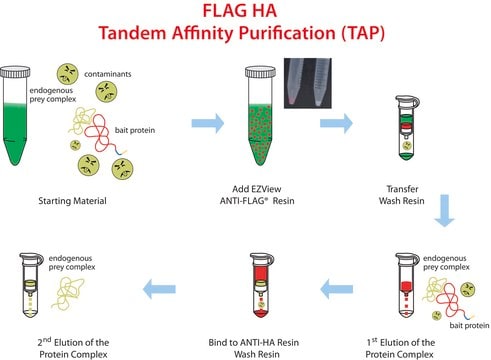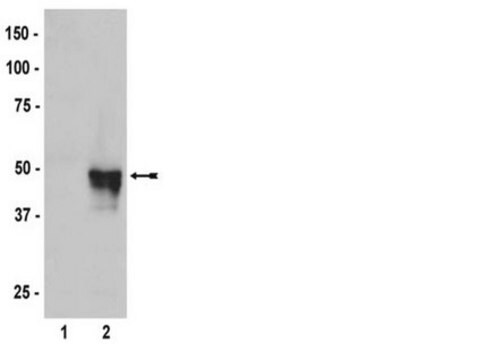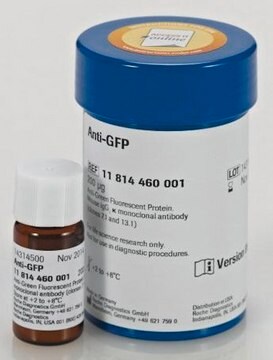11815016001
Roche
Anti-HA Affinity Matrix
from rat IgG1
Synonym(s):
affinity matrix, anti-ha
Sign Into View Organizational & Contract Pricing
All Photos(1)
About This Item
UNSPSC Code:
12352203
Recommended Products
biological source
rat
Quality Level
conjugate
agarose conjugate
antibody form
purified immunoglobulin
antibody product type
primary antibodies
clone
3F10, monoclonal
form
slurry
packaging
pkg of 1 mL (settled resin volume)
manufacturer/tradename
Roche
isotype
IgG1
epitope sequence
YPYDVPDYA
capacity
2-8 nmol/mL binding capacity
storage temp.
2-8°C
General description
Anti-HA High Affinity antibody (clone 3F10) recognizes the 9-amino acid sequence YPYDVPDYA, derived from the human influenza hemagglutinin (HA) protein. This epitope is also recognized in fusion proteins that are derived from mammalian, bacterial, and yeast expression vectors, regardless of its position (N-terminal, C-terminal or internal)
Specificity
Anti-HA High Affinity antibody (clone 3F10) recognizes the 9-amino acid sequence YPYDVPDYA, derived from the human influenza hemagglutinin (HA) protein. This epitope is also recognized in fusion proteins that are derived from mammalian, bacterial, and yeast expression vectors, regardless of its position (N-terminal, C-terminal or internal).
Immunogen
Amino acids 98-106 from the human influenza virus hemagglutinin protein
Application
Following immunoprecipitation or purification, the tagged protein of interest may be analyzed by:
- Western blotting using the Anti-HA antibody
- Silver staining (or similar protein stain)
- In coimmunoprecipitation.
Use Anti-HA Affinity Matrix for:
- Immunoprecipitation of HA-tagged proteins from mammalian, bacterial, and yeast cell extracts
- Affinity column purification of HA-tagged proteins from crude protein extracts
Features and Benefits
- Achieve enhanced specificity and reduced cross-reactivity of Anti-HA High Affinity.
- Use nondenaturing conditions for elution of your HA-tagged protein of choice.
- Purify even rarely expressed HA-tagged proteins.
- Highly specific to YPYDVPDYA.
- Suitable for purification of proteins containing HA-epitop as N-terminal, C-terminal or internal fusion.
- Applicable with crued cell extracts from mammalian, bacterial and yeast expression systems.
Quality
Each lot of Anti-HA Affinity Matrix is tested for its ability to purify a HA-tagged protein expressed in stably transfected cells from a crude mammalian extract. The immunoprecipitate is analyzed by western blot using Anti-HA, High Affinity antibody.
Physical form
1 ml settled resin of Anti-HA Affinity Matrix in PBS containing 0.09% sodium azide (w/v); 2 ml suspension equals to 1 ml bed volume. One plastic column with top and bottom caps is included.
Analysis Note
Yield of 9 nmol purified protein/ml affinity matrix was determined using a whole-cell bacterial extract containing expressed HA-tagged bacterial alkaline phosphatase.
Other Notes
For life science research only. Not for use in diagnostic procedures.
Not finding the right product?
Try our Product Selector Tool.
Storage Class
12 - Non Combustible Liquids
wgk_germany
WGK 1
flash_point_f
does not flash
flash_point_c
does not flash
Choose from one of the most recent versions:
Already Own This Product?
Find documentation for the products that you have recently purchased in the Document Library.
Customers Also Viewed
Francisco José Taberner et al.
BMC cell biology, 11, 47-47 (2010-07-01)
The control of the subcellular localization of cell cycle regulators has emerged as a crucial mechanism in cell division regulation. The active transport of proteins between the nucleus and the cytoplasm is mediated by the transport receptors of the beta-karyopherin
Geetha Hewawasam et al.
Molecular cell, 40(3), 444-454 (2010-11-13)
Cse4 is a variant of histone H3 that is incorporated into a single nucleosome at each centromere in budding yeast. We have discovered an E3 ubiquitin ligase, called Psh1, which controls the cellular level of Cse4 via ubiquitylation and proteolysis.
Abdirahman Abdi et al.
Cellular and molecular life sciences : CMLS, 67(19), 3355-3369 (2010-06-29)
Over the last decade, several protein kinases inhibitors have reached the market for cancer chemotherapy. The kinomes of pathogens represent potentially attractive targets in infectious diseases. The functions of the majority of protein kinases of Plasmodium falciparum, the parasitic protist
David A Hubert et al.
The EMBO journal, 22(21), 5679-5689 (2003-11-01)
The Arabidopsis protein RPM1 activates disease resistance in response to Pseudomonas syringae proteins targeted to the inside of the host cell via the bacterial type III delivery system. We demonstrate that specific mutations in the ATP-binding domain of a single
Stephen C Kales et al.
PloS one, 9(1), e87116-e87116 (2014-01-28)
The Cbl proteins (Cbl, Cbl-b, and Cbl-c) are a highly conserved family of RING finger ubiquitin ligases (E3s) that function as negative regulators of tyrosine kinases in a wide variety of signal transduction pathways. In this study, we identify a
Our team of scientists has experience in all areas of research including Life Science, Material Science, Chemical Synthesis, Chromatography, Analytical and many others.
Contact Technical Service


